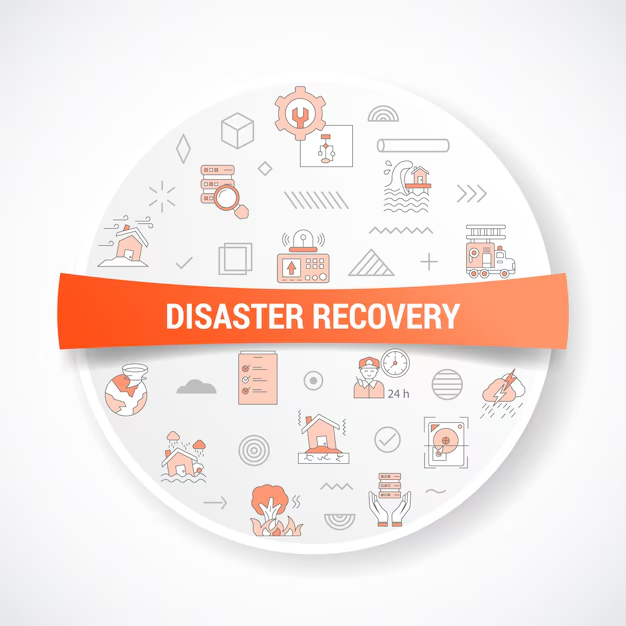Creating an effective disaster recovery plan requires more than theoretical knowledge you need a practical disaster recovery plan example to guide your efforts. Whether facing natural disasters, cyber attacks, or hardware failure, having a comprehensive template ensures business continuity when disruption strikes.
This complete disaster recovery plan example provides actionable templates, step-by-step procedures, and real-world scenarios to help you develop an IT disaster recovery strategy that minimizes downtime and protects critical data. From backup strategies to recovery time objectives, you’ll find everything needed to create a robust plan from scratch.
Related Service: Pittsburgh IT Consulting Company
Essential Components of an Effective Disaster Recovery Plan
From our experience helping organizations develop disaster recovery strategies, a comprehensive disaster recovery plan serves as the cornerstone of business continuity, ensuring organizations can respond swiftly to any type of disaster. An effective disaster recovery plan establishes clear recovery strategies that protect critical systems and maintain essential business operations during disruptions.
Every disaster recovery plan should include several fundamental components. Risk assessment identifies potential threats, from natural disaster to cyber attacks, enabling targeted preparedness measures. Recovery time objectives define acceptable downtime limits, while recovery point objectives establish data loss tolerances. Communication protocols ensure coordinated response efforts across all stakeholders.
The planning framework must address various disaster scenarios comprehensively. Infrastructure mapping identifies critical systems requiring priority protection, while backup procedures safeguard essential data. Testing protocols validate plan effectiveness, ensuring teams can execute recovery strategies under pressure.
Modern disaster recovery planning emphasizes business continuity vs disaster recovery differences integration, aligning recovery efforts with operational priorities. Regular updates maintain plan relevance as business operations evolve. Documentation standards ensure accessibility during crisis situations when quick reference becomes essential.
Successful preparedness requires ongoing commitment beyond initial plan creation. Training programs build response capabilities, while monitoring systems provide early warning indicators for potential disruptions. Organizations must also address outdated disaster recovery assumptions that may compromise modern recovery efforts.
Related Topic: IT Strategy Planning Made Easy: How to Align Tech with Business Goals?
Risk Assessment and Business Impact Analysis Template
We’ve seen firsthand how proper risk assessment prevents costly oversights when conducting a thorough business impact analysis forms the foundation for effective disaster recovery planning. This systematic evaluation helps organizations understand potential vulnerabilities and prioritize protection efforts across their enterprise operations.
The assessment template begins by evaluating disaster scenarios that could affect operations. Organizations must identify a wide range of potential threats, from natural disasters to cyber attacks, examining how each disruption could impact different business functions. This comprehensive approach ensures no critical vulnerabilities remain overlooked during planning phases.
Business impact analysis requires detailed examination of operational dependencies. The framework should identify your critical systems, applications, and data repositories that support essential functions. Each assessment evaluates potential financial losses, operational delays, and reputational damage resulting from various disruption timeframes.
Risk categorization templates help prioritize recovery efforts effectively. High-impact scenarios affecting critical data and core business functions receive immediate attention, while lower-priority disruption events follow established secondary protocols. This structured approach ensures efficient resource allocation during crisis situations.
Stakeholder input proves essential throughout the assessment process. Different departments provide unique perspectives on operational dependencies and potential impact scenarios. Regular stakeholder consultations ensure the business impact analysis remains current as enterprise needs evolve, maintaining assessment accuracy for effective disaster recovery planning. Organizations should also consider BCDR ransomware defense strategies as part of their comprehensive risk assessment.
Related Topic: IT Infrastructure Management for Modern Businesses
Complete Disaster Recovery Plan Example: Step-by-Step Template
In working with clients across industries, this template approach consistently delivers results when providing a comprehensive disaster recovery plan example that organizations can customize for their specific needs. The standardized framework includes all essential components required to build an effective plan from scratch.
Executive Summary Template:
The plan aims to restore critical operations within defined timeframes following any disruption. This disaster recovery plan example outlines specific disaster recovery procedures, contact information, and recovery priorities that guide response efforts systematically.
Recovery Planning Structure:
The template organizes response activities into clear phases. Initial assessment determines incident scope and impact levels. Activation procedures trigger appropriate response teams based on disruption severity. The sequence of steps ensures coordinated recovery efforts across all affected systems and departments.
Implementation Template:
Recovery planning begins with immediate response protocols, followed by short-term stabilization measures, then long-term restoration activities. Each phase includes specific procedures, responsible parties, and completion criteria that teams can follow during actual incidents.
Customization Guidelines:
Organizations should adapt this dr plan template to reflect their unique operational requirements. The steps to create an effective plan involve reviewing each template section, modifying procedures to match existing infrastructure, and conducting regular testing to validate template effectiveness across different recovery scenarios. For additional guidance, review these comprehensive disaster recovery strategies that complement this template approach.
Related Topic: What is vCISO Service? A Practical Guide for SMB Cybersecurity Leadership
Recovery Time Objectives and System Prioritization Framework
Our team regularly helps businesses establish realistic recovery time objectives that form the backbone of effective disaster response planning. Each recovery time objective defines maximum acceptable downtime for specific systems, enabling teams to prioritize restoration efforts during actual incidents.
RTO Framework Development:
Organizations must categorize systems based on business criticality. Tier-1 systems require rapid recovery within minutes or hours, while lower-priority applications can tolerate extended downtime periods. RTOs provide clear targets that guide resource allocation and restoration sequencing during crisis situations.
Recovery Point Objective Integration:
Beyond time considerations, teams must establish recovery point objective limits defining acceptable data loss. Critical systems may require real-time replication, while less essential applications can accept daily backup intervals. These parameters help teams prioritize restoration activities effectively.
Prioritization Matrix:
The framework should prioritize systems systematically. Revenue-generating applications receive highest priority, followed by customer-facing services, then internal productivity tools. This structured approach ensures teams restore operations in optimal sequence, minimizing downtime impact on core business functions.
Implementation Guidelines:
Teams must validate RTOs through regular testing. Bringing systems back online within defined timeframes requires adequate resources, trained personnel, and tested procedures. Organizations should adjust targets based on testing results and operational experience to maintain realistic recovery expectations.
Related Topic: How to Prevent Phishing Attacks and Avoid Costly Data Breaches
Backup and Data Recovery Procedures Template
Through countless recovery scenarios, we’ve learned that backup strategies must combine multiple approaches to create robust data protection frameworks across all critical systems. Effective procedures protect organizations against data loss while ensuring rapid restoration capabilities.
Backup Strategy Framework:
Organizations should implement tiered backup approaches addressing different recovery scenarios. Daily incremental backup captures recent changes efficiently, while weekly full backup provides complete system snapshots. The amount of data determines appropriate backup frequencies and storage requirements for each system tier.
Storage Location Management:
Robust data backup procedures require geographic distribution. Primary backup systems operate within the main data center for rapid access, while offsite backups provide protection against site-wide disasters. Cloud-based backup solutions offer scalable alternatives where backups are stored securely across multiple geographic regions.
Recovery Procedures:
Teams must establish clear protocols for backup data restoration. Testing procedures validate backup integrity regularly, ensuring data remains accessible when needed. Recovery workflows specify restoration priorities, required personnel, and verification steps that confirm successful data recovery operations.
Implementation Standards:
Backup and recovery procedures require ongoing monitoring and validation. Organizations should document retention policies, encryption standards, and access controls that protect backup data throughout its lifecycle. Regular testing confirms backup systems function correctly across different data center scenarios. Consider implementing automated backup and monitoring services to streamline these critical processes.
Related Topic: What Is Zero Trust Security? | Why Every Business Must Adopt It Now
Disaster Recovery Team Roles and Communication Templates
Years of disaster response experience have taught us that communication plans ensure coordinated response during critical incidents. Clear role definitions and communication protocols enable rapid incident response while maintaining stakeholder awareness throughout the recovery process.
Team Structure Template:
The disaster recovery team includes designated leaders, technical specialists, and communication coordinators. Each role carries specific responsibilities for information systems restoration, vendor coordination, and status reporting. Teams should maintain up-to-date contact information for all members, including primary and alternate contacts for each critical position.
Communication Framework:
Structured communication protocols ensure effective coordination during recovery operations. Initial notification procedures alert team members and key stakeholder groups immediately following incident detection. Regular status updates maintain awareness levels while avoiding information overload during critical recovery process phases.
Third-Party Coordination:
External vendor management requires dedicated communication channels. Service management teams coordinate with third-party providers for hardware replacement, software support, and specialized recovery services. Contact details for vendor emergency support lines should remain easily accessible during crisis situations.
Documentation Standards:
Communication templates standardize incident response reporting and stakeholder notifications. These frameworks ensure consistent messaging while reducing coordination overhead during high-stress recovery situations. Regular template updates maintain accuracy as team structures and third-party relationships evolve over time.
Related Topic: Cybersecurity Awareness Training: Best Practices to Stop Cyber Threats
Disaster Recovery Plan Testing and Maintenance Best Practices
We consistently recommend that organizations treat disaster recovery testing as implementing comprehensive testing and maintenance procedures to ensure disaster recovery plans remain effective and current. Organizations must establish systematic approaches that validate plan effectiveness while meeting evolving business requirements and compliance standards.
Testing Framework Best Practices:
Regular testing validates plan components through structured exercises. Tabletop simulations test communication protocols and decision-making processes, while partial system tests verify technical recovery procedures. Full-scale testing provides comprehensive validation but requires careful planning to minimize operational disruption during testing phases.
Maintenance Schedule Development:
A recovery plan must undergo continuous updates reflecting organizational changes. Quarterly reviews address personnel changes, system modifications, and updated contact information. Annual comprehensive assessments evaluate plan testing results and incorporate lessons learned from actual incidents or industry best practices.
Documentation Management:
Organizations should store your document versions securely with version control systems. The disaster recovery plan checklist helps track required updates, ensuring all components remain current. Digital storage solutions simplify access during emergencies while maintaining backup copies across multiple locations.
Compliance Integration:
Testing schedules must align with compliance requirements specific to each industry. Regular audits verify adherence to regulatory standards while identifying improvement opportunities. These practices help ensure business continuity planning meets both operational needs and regulatory obligations, enabling organizations to mitigate risks effectively. Consider implementing compliance-ready disaster recovery frameworks to streamline regulatory requirements. Additionally, understanding common business continuity planning failures helps organizations avoid typical testing pitfalls.
Related Topic: What Is Ransomware and How to Stop It Before It Spreads
Final Thoughts:
This detailed disaster recovery plan example highlights how proactive preparation can turn potential crises into manageable recovery steps. By applying the templates, strategies, and best practices shared above, businesses can minimize downtime, safeguard data, and restore operations efficiently after any disruption. However, it’s important to remember that a disaster recovery plan is only as strong as its regular testing, updates, and adaptability to new risks.
Ready to Get Started?
If your organization is ready to take disaster recovery to the next level, consider partnering with experts who specialize in IT resilience. Right Hand Technology Group offers advanced solutions like RightSentry Core™, providing automated backups, continuous monitoring, and comprehensive cybersecurity protection. To identify vulnerabilities and strengthen your defenses, start with the RightSentry Snapshot™ assessment—a clear first step toward building a stronger recovery strategy.
Frequently Asked Questions
What should be included in a disaster recovery plan template?
A comprehensive template should include risk assessments, recovery procedures, contact lists, and system priorities. Your disaster recovery plan should include backup strategies, communication protocols, and testing schedules. Essential template components cover incident response workflows, vendor contacts, and recovery time objectives for systematic disaster management.
How do you develop an IT disaster recovery plan from scratch?
To develop an IT disaster recovery plan, begin with business impact analysis and risk assessment. Recovery planning involves identifying critical systems, establishing recovery priorities, and creating detailed procedures. Effective recovery planning requires stakeholder input, vendor coordination, and regular testing to ensure comprehensive protection.
What are common types of disasters that affect business operations?
Organizations face various threats including natural disasters like floods, earthquakes, and storms. Cyber attacks target data systems through malware and ransomware. Hardware failure affects servers and network equipment. Power outages disrupt operations facility-wide. Each disaster type requires specific response strategies.
How often should disaster recovery plans be tested?
Testing should occur quarterly to identify potential issues before actual outage events. Regular exercises prevent business disruption by validating procedures and training teams. Each disruptive event provides learning opportunities. Annual comprehensive testing addresses system changes while monthly outage simulations maintain team readiness and minimize service interruption risks.
What is the difference between failover and backup in disaster recovery?
Failover automatically switches operations to secondary server systems when primary systems fail, enabling seamless continuity. Backup creates data copies for restoration purposes. On-premises failover provides immediate switching capabilities, while backup requires manual restoration processes. Both approaches complement each other in comprehensive disaster recovery strategies.











